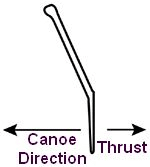
There are lots of claims about the efficiency and wonders of Bent Shaft paddles - Shawn Burke probably makes the best case. Although I don't typically use one, unless I am on a longer lake 'cruise', I do agree that they do provide an increase in efficiency. The increased efficiency may mean a faster ride, more energy to spare at the end of a long paddling day, or reduced chance of repetitive strain injuries. There are various claims on how much extra you can get out of a bent shaft but there is very little actual research to substantiate the claims (number range from 2-15%). The increase can translate to a few extra kilometres over a day of paddling, or a little increase in speed (maybe 1-2km/hr).
The consensus seems to be a bend of 12 degrees (although there is lots of discussion ranging from 10-15 degrees) provides the optimal touring paddle. The overall length of the paddle should be shorter than your 'normal' touring straight shaft paddle. Here again there is lots of discussion, some people actually like a longer bent shaft paddle. My bent shaft paddle(s) is a little shorter overall, but the actual shaft length is about the same as my normal touring paddle.

Back to Home Page
Back to my Canoe Instruction WWW page
July 20, 2019